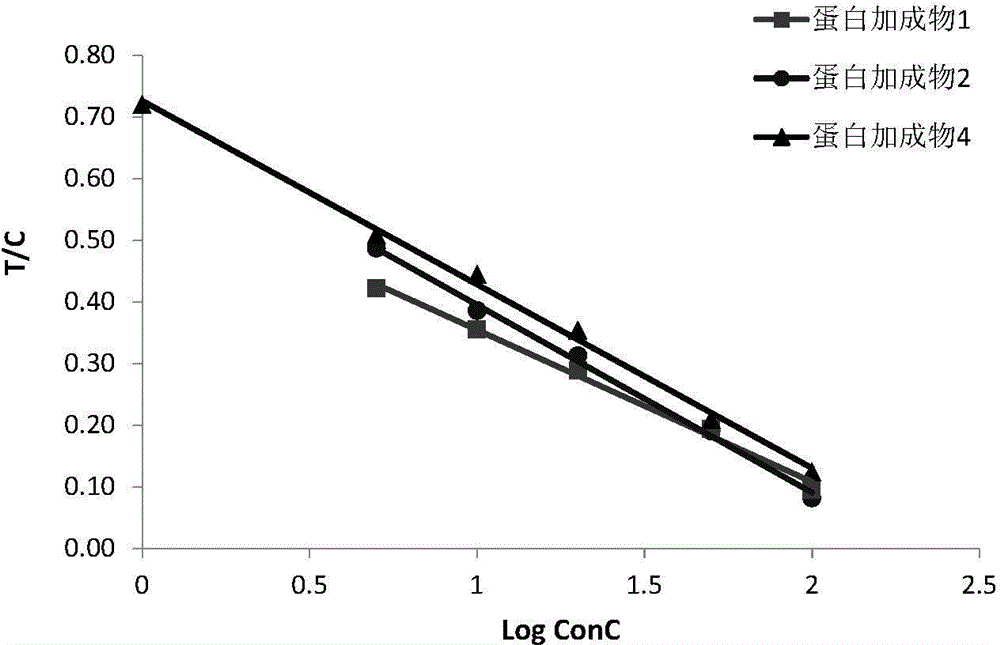Rapid noninvasive female corpus luteum function monitoring technology
An antibody and conjugate technology, applied in the field of non-invasive monitoring of female fertility, to reduce steric hindrance, avoid non-specific binding, and improve pregnancy success rate
- Summary
- Abstract
- Description
- Claims
- Application Information
AI Technical Summary
Problems solved by technology
Method used
Image
Examples
Embodiment 1
[0067] Example 1: PdG-Linker-CO 2 Preparation of H(1)
[0068] PdG (0.1 mmol) was dissolved in DMF (0.5 mL), and a DMF solution (0.8 ml) of DCC (0.143 mmol) and NHS (0.143 mmol) was added. The reaction mixture was stirred for 7 hours, then a solution of 6-aminocaproic acid (0.119 mmol) in chloroform (1 mL) and triethylamine (0.5 mL) was added. The reaction was stirred overnight, and after removal of the solvent, the residue was chromatographed on silica gel with dichloromethane:methanol (8:2): the product PdG-Linker-CO 2 H (1; 0.025 mmol). Yield: 25%.
Embodiment 2
[0069] Embodiment 2: Preparation of PdG-Linker-OVA conjugate (1)
[0070] PdG-linker-CO 2 H (1; 0.05mmol) in a small test tube, add 0.2ml of the above DCC / DMF solution under stirring to dissolve, then add 0.2ml, and let it react at room temperature for 3 hours until a large amount of precipitation (urea is its by-product) . NaH 2 PO 4 .2H 2 O (0.1186g) and anhydrous Na 2 HPO 4 (0.46g) was dissolved in 20ml of water to prepare 0.2M phosphate buffer (pH7.4). At 4°C, OVA (44.34 mg, 1 μmol) was stirred and dissolved in the above 4 ml, 0.2 M phosphate buffer solution; the above DCC / NHS PdG solution (0.4 ml DMF solution) was dropped into the OVA solution under stirring. The coupling reaction of PdG-linker-OVA was stirred overnight at 4°C. The PdG-Linker-OVA conjugate was dialyzed against water 4 times (1.2 L each time) for 48 hours, and then dialyzed against phosphate buffer (1.2 L, pH7.4) for 24 hours. The purified PdG-Linker-OVA conjugate (1) was dialyzed and collected, f...
Embodiment 3
[0071] Embodiment 3: Preparation of PdG-Linker-OVA conjugate (2-4)
[0072] In a similar manner to Example 1 above, three portions of PdG (0.1 mmol) were dissolved in DMF (0.5 mL), and a DMF solution (0.8 ml) of DCC (0.143 mmol) and NHS (0.143 mmol) was added. The reaction mixture was stirred for 7 hours, then 7-aza-8-oxo-13-amino-tridecanoic acid, 7,14-diaza-8,15-dioxo-20-amino-tridecanoic acid, 7,14-diaza-8,15-dioxo-20-amino-di Decanoic acid and 4-oxo-5-aza-9,12,15-trioxa-18-amino-octadecanoic acid (0.119 mmol) in chloroform (1 mL) and triethylamine (0.5 mL) . The reaction was stirred overnight, and after removal of the solvent, the residue was chromatographed on silica gel with dichloromethane:methanol (8:2): the product PdG-Linker-CO 2 H (2-4; 0.023-0.026 mmol). The yields were: 23-26%, respectively.
[0073] With the method of above-mentioned embodiment 2, take above-mentioned PdG-linker-CO respectively 2 H (2-4; 0.05mmol) in a small test tube, add 0.2ml of the above...
PUM
| Property | Measurement | Unit |
|---|---|---|
| Sensitivity | aaaaa | aaaaa |
| Sensitivity | aaaaa | aaaaa |
| linear range | aaaaa | aaaaa |
Abstract
Description
Claims
Application Information
 Login to View More
Login to View More - R&D Engineer
- R&D Manager
- IP Professional
- Industry Leading Data Capabilities
- Powerful AI technology
- Patent DNA Extraction
Browse by: Latest US Patents, China's latest patents, Technical Efficacy Thesaurus, Application Domain, Technology Topic, Popular Technical Reports.
© 2024 PatSnap. All rights reserved.Legal|Privacy policy|Modern Slavery Act Transparency Statement|Sitemap|About US| Contact US: help@patsnap.com










